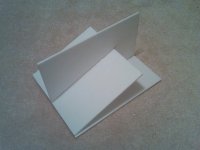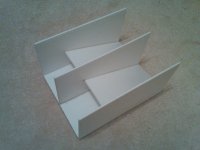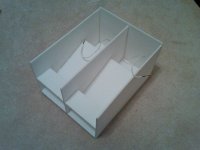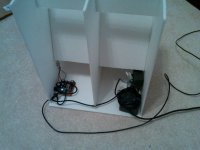For your viewing pleasure: Henkjan's desktop TL in foam board.
Compared to my cornus, these are much more quick-and-dirty, however I am much more pleased with the result. I'll definitely be making a real pair as soon as I am able.
I LIKE those speakers! Did you take any internal pics? How big is the mouth in the rear?
BIB with Foam Core and Vifa
I might try this next with the Vifa's and foam core - based on Jhutka's build in wood and burlap.
diyAudio
The box will be 27 in tall and 6-3/8 in x 8-3/8 in deep assuming 3/16 in thick foam core boards. The 27 in height is perfect as it is under 30 in length of Dollar store foam core stock.
The BIB Calculator (xls spreadsheet) is available here: diyAudio
I might try this next with the Vifa's and foam core - based on Jhutka's build in wood and burlap.
diyAudio
The box will be 27 in tall and 6-3/8 in x 8-3/8 in deep assuming 3/16 in thick foam core boards. The 27 in height is perfect as it is under 30 in length of Dollar store foam core stock.
The BIB Calculator (xls spreadsheet) is available here: diyAudio
BP1, I didn't take an internal pic but there is still a hole in the side that I could snap a photo of. Actually, just take a look at this thread and you'll get an exact idea of what I did:I LIKE those speakers! Did you take any internal pics? How big is the mouth in the rear?
http://www.diyaudio.com/forums/full-range/124449-desktop-tl-3-driver-real-bass.html
So you can see that the mouth is very small. These speakers have a lot of promise though! Even with foam core, I tested the bass as being good to the mid- to low-fifties and I'm sure the sound would be much better in wood. I expect to get around to making a proper version of these as well as some other speakers in March or April.
Chaz,
Those TL speakers with the small opening do look really nice. Awesome to hear that they go down to the 50's. They make me think of a BIB flipped around. I guess it works either way but BIB will have more output due to bigger mouth
A camera on hand during builds is a must in this forum!
Those TL speakers with the small opening do look really nice. Awesome to hear that they go down to the 50's. They make me think of a BIB flipped around. I guess it works either way but BIB will have more output due to bigger mouth
A camera on hand during builds is a must in this forum!
Micro Stereo BIB - new build
I had left over cuttings of foam from the last horn build and decide to make a little stereo mp3 player box with some drivers and amp pulled from the Logitech S120 pc speakers. I was inspired by Jhutka's little Vifa BIB and wondered what it would sound like if taken even smaller. Using the BIB calculator spreadsheet, I plugged in the Fs, Qts, and Vas for a Visaton FRS5 which I think looks closest to the drivers from the S120. The calculator gave a box size of 5 in x 7 in x 13 in tall with a 10 in long divider. I wanted to make a stereo pair so the overall box will be 10 in wide. Accounting for the 3/16 in thick foam cores, the overall dimensions were just a little bigger. The build was extremely easy and I can see why the BIB design is so popular. That is about as far as I got, I will fire it up and report on the sound later.
A very easy 2 hour project.
I had left over cuttings of foam from the last horn build and decide to make a little stereo mp3 player box with some drivers and amp pulled from the Logitech S120 pc speakers. I was inspired by Jhutka's little Vifa BIB and wondered what it would sound like if taken even smaller. Using the BIB calculator spreadsheet, I plugged in the Fs, Qts, and Vas for a Visaton FRS5 which I think looks closest to the drivers from the S120. The calculator gave a box size of 5 in x 7 in x 13 in tall with a 10 in long divider. I wanted to make a stereo pair so the overall box will be 10 in wide. Accounting for the 3/16 in thick foam cores, the overall dimensions were just a little bigger. The build was extremely easy and I can see why the BIB design is so popular. That is about as far as I got, I will fire it up and report on the sound later.
A very easy 2 hour project.
Attachments
Last edited:
Update on BIB
The sound is very nice, too much bass actually, if that is even possible with a 2 in driver. I had to add extra stuffing all the way past the fold point to balance the sound. It's a very nice sounding mp3 player now. I can only imagine what the bass from an 8 in driver and 72 in tall cabinet sounds like.
The sound is very nice, too much bass actually, if that is even possible with a 2 in driver. I had to add extra stuffing all the way past the fold point to balance the sound. It's a very nice sounding mp3 player now. I can only imagine what the bass from an 8 in driver and 72 in tall cabinet sounds like.
Used a 7 year old 4" CSS driver no xover. Powered by a Lepai 2020A+. About 5w of clean output.
Very clean, clear sound and good bass until 60hz.
Box: 4.5w x 7.5h x 10d
Made the box as small as I wanted for a computer speaker, no box calculations were harmed during this build. The driver flange is 5" so it overhangs the box.
Used packing tape as a sealant! Ugly...but its only a quick test...that may last a long time.
The foam core box is semi-transparent to the music, giving it a pleasing, open, room filling sound.
Foam core is 3/16 thick 20x30 sheets from AC Moore for $1.97 each.
The foam patch on front is where I tried a port and covered it back up.
Stuck a 4" x 1.5" port tube in the back side of the box.
Using this youtube video:Ultimate Bass Test : 100 hz - 1 hz | Sine Wave Subwoofer Tester Tones : 100hz to 1hz - MY BEST EVER - YouTube
The bass output is very flat until 60-65hz then rolls off. Yeah, too lazy to pull out the mic and stuff to measure it!

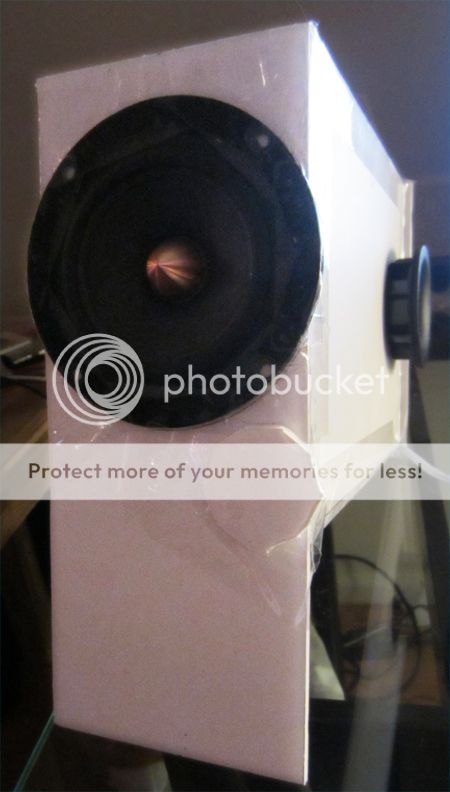
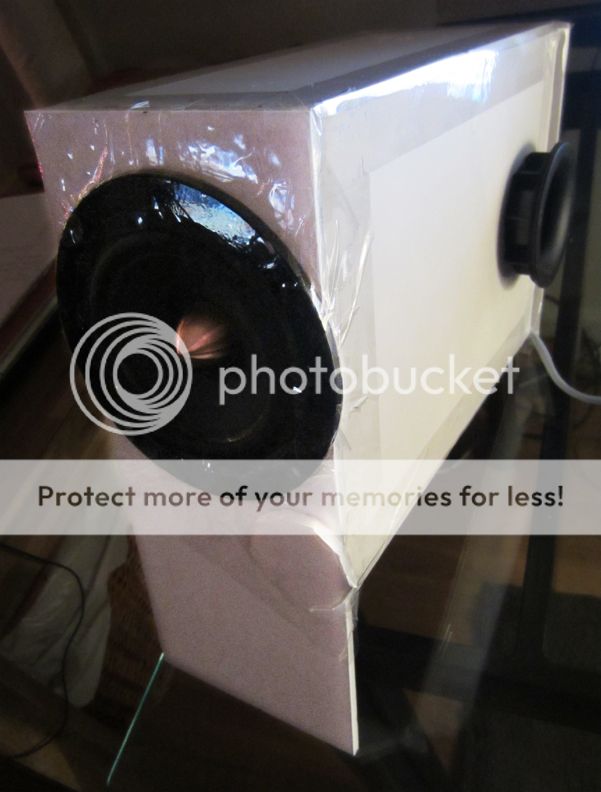
Very clean, clear sound and good bass until 60hz.
Box: 4.5w x 7.5h x 10d
Made the box as small as I wanted for a computer speaker, no box calculations were harmed during this build. The driver flange is 5" so it overhangs the box.
Used packing tape as a sealant! Ugly...but its only a quick test...that may last a long time.
The foam core box is semi-transparent to the music, giving it a pleasing, open, room filling sound.
Foam core is 3/16 thick 20x30 sheets from AC Moore for $1.97 each.
The foam patch on front is where I tried a port and covered it back up.
Stuck a 4" x 1.5" port tube in the back side of the box.
Using this youtube video:Ultimate Bass Test : 100 hz - 1 hz | Sine Wave Subwoofer Tester Tones : 100hz to 1hz - MY BEST EVER - YouTube
The bass output is very flat until 60-65hz then rolls off. Yeah, too lazy to pull out the mic and stuff to measure it!



Last edited:

I got some plastic boxes (heresy on this board!) that I want to glue these Aurasound drivers into.
What glue would create a lasting and airtight seal for metal (driver) and Plastic (box)?
Thanks
You probably can guess what my answer will be: Hot melt glue. It sticks to metal very well -try scraping it off after it hardens to test. Plastic will depend on type. If it is the slippery HDPE or LDPE (high/low density polyethylene), you may need to roughen plastic with sandpaper for durable bond. For ABS, PVC, it sticks very well. For polypropylene (the stuff that they make storage bins out of), it sticks very well, but sand paper first to make sure it stays.
Silicone caulking or latex caulking will work well, but is soft and springy.
Liquid nails will work well.
Good luck!
Silicone caulking or latex caulking will work well, but is soft and springy.
Liquid nails will work well.
Good luck!
Well that does it !! Last Sunday my son informed me that his friend had several tickets for the NFC championship game in Atlanta (he lives there), but he had no plans to send me one - along with boarding pass. Now you are going to Maui without even a thought that I might like to go along. I just don't understand.
Oh Well, Enjoy the trip and give your Dad a peck on the cheek for all of us back here shoveling snow.
Oh Well, Enjoy the trip and give your Dad a peck on the cheek for all of us back here shoveling snow.
Last edited:
You guys have fun. I'll be away from a computer till the 25th. Heading to Maui for our annual trip to see Dad.
That's just rubbing it in Cal.
Well that does it !! Last Sunday my son informed me that his friend had several tickets for the NFC championship game in Atlanta (he lives there), but he had no plans to send me one - along with boarding pass. Now you are going to Maui without even a thought that I might like to go along. I just don't understand.
Oh Well, Enjoy the trip and give your Dad a peck on the cheek for all of us back here shoveling snow.
Lol!
I believe Sootboots is the first to make a simple sealed box for a great 2 way FAST system. Thread is here http://www.diyaudio.com/forums/full-range/228114-sb-8-inch-woofer-sounds-great-its-own-2.html
Congrats Sootboots!

Congrats Sootboots!
I am flattered but it was suggestions from the forum that landed me here. Without you all I would be stuck listening to the Costco cardboard specials! All joking aside, the foam core route is an excellent way to experiment and a bit of fun as well. The best part is you can have a few beer while you are making them, unlike working with MDF and a table saw.
John
John
So I built my first foam core speaker today based on reading this thread. Thanks to all for the contributions.
I used a 5" fullrange el cheapo driver ($2) with an Fs <50Hz, Qts of ~0.3. I originally bought them to try out some boxes for an el cheapo home theater, but never got around to doing that. I built a Golden Ratio box with mid dimension as the speaker baffle (wider than it is deep), with speaker offset and port (approx 6x11x17 for a 0.75 cu ft box). I'll try another with the driver and port mounted on the smallest dimension. Perhaps obviously, I'm a speaker newbie.
A few observations FWIW:
1) It's a great technique to prototype, but I for one won't live with them as a final build. Too much cabinet resonance and too hard to get a well sealed box. Maybe it's the cabinet resonance that makes some projects seem to have so much bass?
2) I've never had great success using hot glue, but, still, hot gluing any seam over 10" seems prone to failure unless you work v quickly (otherwise, the glue starts to set as it cools, and the joint is prone to failure). In any case, it's possible to get a joint this way, but be prepared for failure. And you DO need to hold it for a bit for it to set. This may have been exacerbated by the fact that I used old and warped foam core panels that had been used for a display for a low-budget non-profit I used to work with, and required several hands to flatten out warps as the glue set.
3) I tried contact cement on a few joints to try to get a quick strong bonding alternative to hot glue. While it worked pretty well, it DID melt the foam in the core a bit, which also weakens the joint and affects the structure a bit. Still, the joint is pretty strong and the bonding is very quick, so maybe it's a decent alternative fastening technique. Work in a well ventilated area...
4) If you try contact cement, try cutting the panels 1/8 inch (0.3cm) or so heavy (at each joint) and clamp strongly when assembling to compress the extra size. A 7" wide panel becomes about 7.25" before gluing.
Despite my various complaints, I probably will adopt this as a prototype system as the cost (materials and time) is quite low. My idea of prototyping is to do a quick build and get an idea of how it will sound before investing in a full build. While an accurate sense of how a speaker will sound will require a more careful build, I think I can eventually develop a general sense of performance in a foam core box that I can use to predict performance in a wooden box...
We'll see, but I'll certainly try more with foam core.
I used a 5" fullrange el cheapo driver ($2) with an Fs <50Hz, Qts of ~0.3. I originally bought them to try out some boxes for an el cheapo home theater, but never got around to doing that. I built a Golden Ratio box with mid dimension as the speaker baffle (wider than it is deep), with speaker offset and port (approx 6x11x17 for a 0.75 cu ft box). I'll try another with the driver and port mounted on the smallest dimension. Perhaps obviously, I'm a speaker newbie.
A few observations FWIW:
1) It's a great technique to prototype, but I for one won't live with them as a final build. Too much cabinet resonance and too hard to get a well sealed box. Maybe it's the cabinet resonance that makes some projects seem to have so much bass?
2) I've never had great success using hot glue, but, still, hot gluing any seam over 10" seems prone to failure unless you work v quickly (otherwise, the glue starts to set as it cools, and the joint is prone to failure). In any case, it's possible to get a joint this way, but be prepared for failure. And you DO need to hold it for a bit for it to set. This may have been exacerbated by the fact that I used old and warped foam core panels that had been used for a display for a low-budget non-profit I used to work with, and required several hands to flatten out warps as the glue set.
3) I tried contact cement on a few joints to try to get a quick strong bonding alternative to hot glue. While it worked pretty well, it DID melt the foam in the core a bit, which also weakens the joint and affects the structure a bit. Still, the joint is pretty strong and the bonding is very quick, so maybe it's a decent alternative fastening technique. Work in a well ventilated area...
4) If you try contact cement, try cutting the panels 1/8 inch (0.3cm) or so heavy (at each joint) and clamp strongly when assembling to compress the extra size. A 7" wide panel becomes about 7.25" before gluing.
Despite my various complaints, I probably will adopt this as a prototype system as the cost (materials and time) is quite low. My idea of prototyping is to do a quick build and get an idea of how it will sound before investing in a full build. While an accurate sense of how a speaker will sound will require a more careful build, I think I can eventually develop a general sense of performance in a foam core box that I can use to predict performance in a wooden box...
We'll see, but I'll certainly try more with foam core.
Just a note. I agree it is fun to experiment with the foam board, but we should remember that the spiral/spacing on the Cornu is somewhat unique to the rigidity of that design. Where the air pressures are highest (near the throat) - the unsupported areas are the smallest. Not till the second half of the horn is there any real chance of flexing. I haven't built a Cornu or anything else with foam core only, but I wouldn't expect as good a result without that spiral combined with the stiffness of at least 1/4" plywood walls. IMHO, there is a little magic in the match up of the foam and the spiral that would be difficult to get from any other design using the same materials.
My Two Cents
My Two Cents

- Home
- Loudspeakers
- Full Range
- Foam Core Board Speaker Enclosures?
